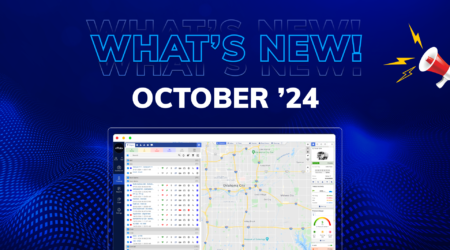The Integration of Video Telematics in Canadian Fleet Management Practices
In today’s technological landscape, the integration of video telematics into fleet management practices is transforming the Canadian transportation sector. This integration is not just a trend but a pivotal shift toward enhancing safety, efficiency, and operational intelligence.
 What is Video Telematics?
What is Video Telematics?
Video telematics represents a transformative blend of video technology and telematics data. It is specifically designed to enhance fleet operations comprehensively. At its core, this technology integrates sophisticated dashboard cameras and a suite of sensors installed within fleet vehicles to capture a range of data in real-time. These devices meticulously record everything from road conditions and vehicle performance metrics to driver behavior and external environmental factors.
The captured video and sensor data are transmitted to a centralized system where advanced analytics are applied. This analysis enables fleet managers to gain deep insights into daily operations, assess vehicle health, and monitor driver performance continuously. By leveraging this data, businesses can make informed decisions to optimize fleet efficiency, enhance safety protocols, and mitigate risks associated with vehicle operation. Additionally, the visual evidence collected helps in addressing insurance claims more effectively, training drivers based on actual incidents, and reinforcing good driving practices across the fleet.
The Role of Video Telematics in Fleet Management
Enhancing Driver Safety
Incorporating video telematics into fleet management significantly boosts driver safety—one of the paramount concerns for any fleet operator. This technology provides a real-time feedback loop and historical data that help identify hazardous driving behaviors such as speeding, harsh braking, and sudden lane changes. Through continuous monitoring, fleet managers can implement targeted interventions, such as personalized coaching or comprehensive training programs tailored to the specific needs of each driver. This proactive approach not only reduces the likelihood of accidents but also fosters a culture of safety among drivers, which is critical in minimizing liabilities and enhancing the overall safety of roadways.
Increasing Operational Efficiency
Video telematics also plays a pivotal role in elevating operational efficiency within fleet management. By integrating real-time video feeds with telematics data, fleet operators can streamline route planning and optimize schedules based on traffic conditions, vehicle location, and delivery timelines. This level of integration helps in reducing unnecessary idling times, improving fuel efficiency, and minimizing vehicle downtime. Furthermore, the insights gained from video telematics enable predictive maintenance, whereby fleet managers can schedule vehicle repairs and maintenance based on actual vehicle condition rather than relying on generic schedules. This not only extends the lifespan of the fleet but also ensures vehicles are running at peak efficiency, thereby reducing operational costs over time.
Moreover, the data provided by video telematics supports compliance with various regulatory standards, ensuring that fleets adhere to legal requirements and industry best practices. This compliance is critical to maintaining operational licenses and avoiding costly fines, contributing to the sustainable management and growth of fleet operations.
Supporting Regulatory Compliance
In Canada, regulatory compliance is a key concern for fleet managers. Video telematics helps ensure compliance with regulations such as the Electronic Logging Device (ELD) mandate and hours of service (HOS) requirements. By providing accurate and verifiable data, video telematics systems help fleets avoid penalties and fines associated with non-compliance.
Transformative Impact on Safety
Safety is paramount in fleet management. Video telematics is revolutionizing this aspect by providing real-time visual monitoring of vehicles and drivers. With the ability to directly observe driver behavior and road conditions, fleet managers can immediately address potential safety issues. For instance, if a driver frequently engages in distracted driving, video telematics can pinpoint these behaviors, allowing for timely intervention through targeted training or direct feedback. This proactive approach significantly reduces the risk of accidents. It also enhances the safety of drivers and other road users and minimizes potential liabilities for companies.
A Pivotal Shift in the Industry
The move towards integrating video telematics in Canadian fleet management is indicative of a broader shift towards data-driven decision-making in the transportation industry. This shift is not merely about adopting new technologies but about fundamentally changing how fleets operate to stay competitive. As such, video telematics is not just enhancing individual aspects of fleet operations but is transforming the industry at a structural level. It is driving towards greater safety, efficiency, and intelligence in a cohesive and integrated manner.
Together, these aspects of video telematics ensure that fleets not only operate more safely and efficiently but also align with regulatory frameworks, maximizing their operational potential while safeguarding their drivers and the communities in which they operate.
Case Studies: Impact of Video Telematics in Canadian Fleets
Case Study 1: Improved Driver Safety
A Toronto-based logistics company implemented video telematics across its fleet of 100 trucks. Within six months, the company reported a 30% reduction in speeding incidents and a 40% decrease in at-fault accidents. Video telematics enabled the fleet managers to effectively coach drivers and improve driving behaviors, leading to a safer working environment.
Case Study 2: Enhanced Operational Efficiency
A Vancouver-based retail chain adopted video telematics to optimize its delivery operations. The technology allowed the company to monitor real-time traffic conditions and adjust routes accordingly, reducing delivery times by an average of 15%. This not only improved customer satisfaction but also lowered operational costs.
Future Trends in Video Telematics
The future of video telematics in Canadian fleet management looks promising. Advances in artificial intelligence (AI) and machine learning (ML) are expected to further enhance the capabilities of video telematics systems. These technologies can automate the analysis of video data, providing even more insights into fleet operations and driver behavior.
Furthermore, the integration of video telematics with other technologies such as Internet of Things (IoT) devices and autonomous vehicles is likely to drive innovation in the fleet management industry. This integration will enable more sophisticated data analysis and decision-making processes, further improving fleet efficiency and safety.
Conclusion
The integration of video telematics into Canadian fleet management practices is revolutionizing the industry. By enhancing driver safety, increasing operational efficiency, and supporting regulatory compliance. Video telematics is proving to be an invaluable tool for Canadian fleet operators.
Embracing this technology not only contributes to safer roadways but also to a more efficient and compliant fleet, underscoring the importance of video telematics in modern fleet management practices. As technology continues to evolve, the potential for further enhancements in fleet management is limitless. It promises a safer, more efficient, and more compliant future for Canadian fleets.


 What is Video Telematics?
What is Video Telematics?

